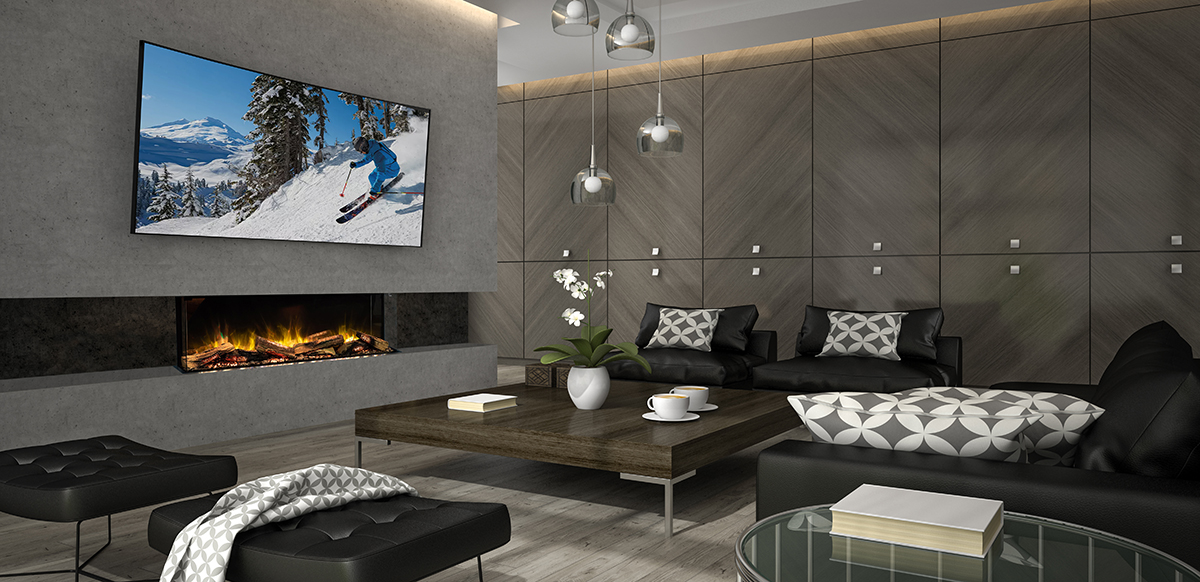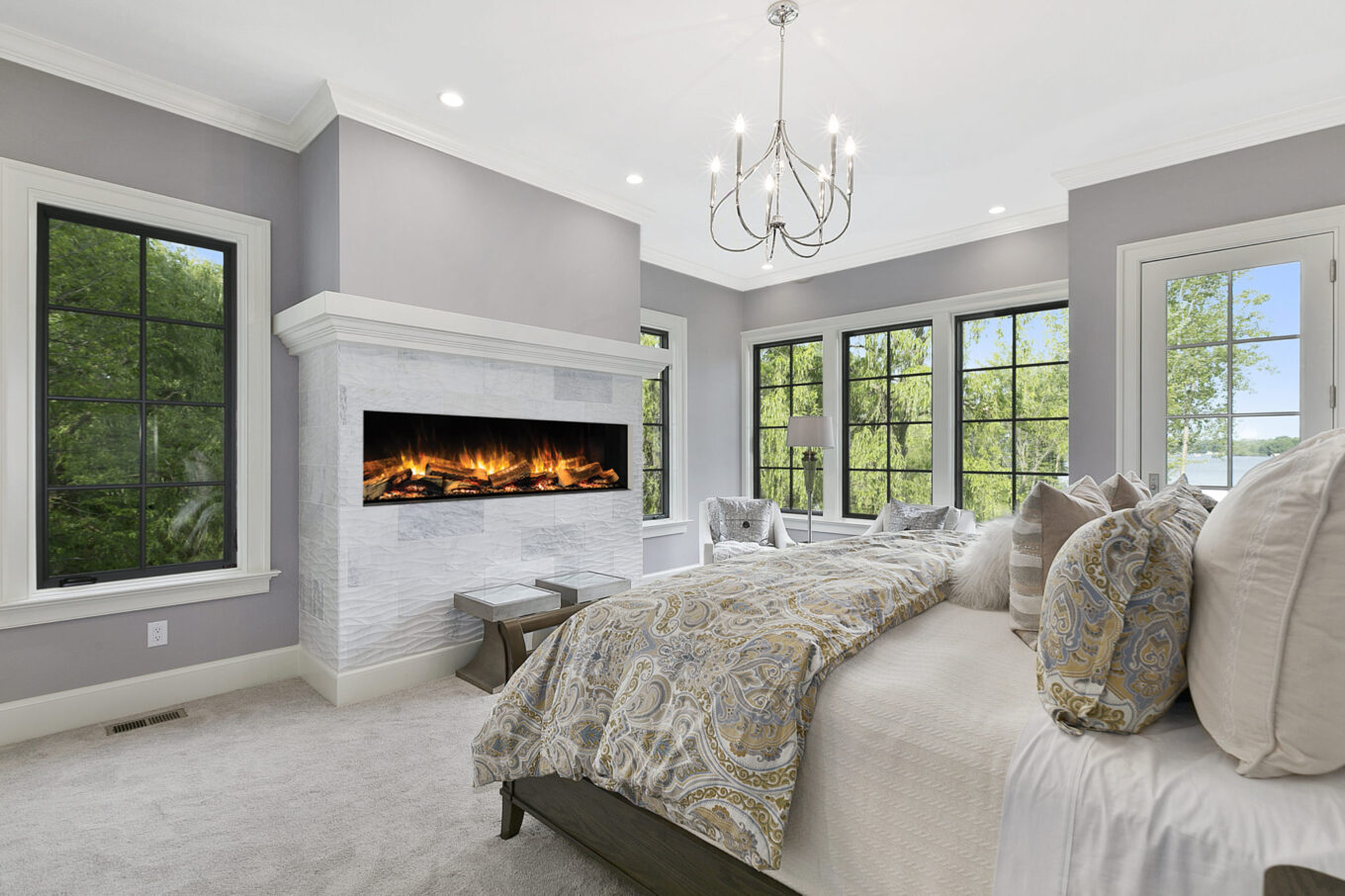Many homeowners are choosing electric fireplaces over gas ones. So much so that the global electric fireplace market is expected to grow at an annual rate of 3.7% from 2022 to 2032. (Future Insights). But why? Are they really the same? Do they offer the same heat and aesthetic?
The short answer is yes. Electric fireplaces of the past were nothing more than some fake logs, incandescent bulbs, and reflective foil to replicate flames. Today, electric fireplaces have gone way beyond that.

With an impressive build like the one above it’s hard to tell this E-FX 1300 by Flamerite is an electric fireplace.
Electric Fireplaces 101
Electric fireplaces are heating devices that simulate the look of a traditional wood-burning or gas fireplace using LED lights and a heating element. They basically give the same ambiance and warmth of a fireplace without the need for combustion, venting, or chimney maintenance. Electric fireplaces also come in many styles, including wall-mounted units, freestanding models, inserts for existing fireplaces, and built-in designs.

Modern interior, living room featuring the E-FX Slim Line 750S by Flamerite.
How can you use them? Are there advantages to owning one?
Although electric fireplaces are more commonly used for heating small to medium-sized rooms, they have other uses too! They can create a cozy and inviting atmosphere thanks to their realistic flames, serve as a conversation starter, and enhance your home’s interior design. Plus, you can adjust the flames to your liking with just a click.

Milan Suite by Flamerite
But it’s not all about aesthetics; they also come with many advantages over traditional fireplaces, such as:
- Simple to install. You usually only need an electrical outlet, as they can be simply plugged into an outlet, eliminating the need for a chimney or gas line.
- Minimal Maintenance. Unlike wood-burning or gas fireplaces, there is no need to clean ash or soot, and they don’t produce harmful emissions.
- Safer. As there is no open flame, you are reducing the risk of accidental fires. Many models also come with safety features such as automatic shut-off.
Energy-efficient. Electric fireplaces convert nearly all the electricity they use into heat. They also allow for zone heating, meaning you can heat specific areas without having to heat the entire home.

Flamerite fireplaces connect to your device with the free App. Control every aspect of your fireplace with ease. Works with Google Home and Amazon Alexa.
Electric vs Gas Fireplaces
Now that we understand what electric fireplaces are and how you can use them, you may be wondering: should I go for an electric or gas fireplace? To answer this question, you need to understand the differences in their performance, installation, costs, and environmental impact. Here’s a breakdown to help guide your choice.
How each fireplace is installed differs considerably. For starters, gas fireplaces need a connection to a gas line, and most models need venting to the outside, either through a chimney or a direct vent system. This makes it a more complex and costly installation, especially if your home doesn’t already have a gas line or chimney.
On the other hand, electric fireplaces are much easier to install, as they typically only need a standard electrical outlet! And, since they don’t require venting, chimneys, or gas lines, they can be installed in a wider range of locations within your home.

Enjoy a comfy night at home with the E FX 1500 electric fireplace by FLamerite.
Cost
The overall cost of a fireplace, regardless if it’s powered through electricity or gas, includes the purchase price, installation, maintenance, and operational expenses.
However, gas fireplaces usually come with a higher upfront cost, both for the unit and installation – particularly if extensive venting or gas line work is necessary.
On the other hand, electric fireplaces tend to be more affordable when it comes to purchase and installation and the cost depends on local electricity rates, which can vary widely.
Environmental Impact
When it comes to environmental impact, electric fireplaces tend to be more eco-friendly, as they produce no direct emissions. However, the overall environmental footprint of an electric fireplace largely depends on how the electricity is generated. For instance, if it uses renewable sources, it can significantly lower its impact.
When it comes to gas fireplaces, their heating process releases carbon dioxide and other combustion byproducts. So, while these fireplaces are more efficient at heating larger spaces, they do contribute to greenhouse gas emissions. However, newer models are designed to burn gas more cleanly and efficiently, reducing their environmental impact compared to older units.

E-FX 1800 3-Sided by Flamerite
What about the heat?
Yes, electric fireplaces do give off heat and, although its amount can vary, most models have a heat output of around 4,000 to 5,000 BTUs (British Thermal Units) per hour, which is enough to heat a room of approximately 400 square feet. But, for those of you who aren’t well-versed in heat output language, electric fireplaces are usually sufficient for smaller areas or as supplemental heating. And, although less powerful than a gas fireplace, they convert nearly all the energy they consume into heat, making them highly efficient in terms of energy usage, even if they’re less capable of warming large spaces.

Capella Suite by Flamerite
Final Thoughts
With the proper wall space and electric hookup, you can be comfortable and mesmerized by the beauty and elegance of these built-in fireplaces. From designer surrounds, to two and three-sided models with a stone hearth, evolving fireplace technology has brought not only the element of fire into a home, but the element of a safe and dramatic design.
Get yourself an electric fireplace at European Home today and enjoy a convenient, safe, and versatile option for adding warmth and ambiance to your home.
Disqus comments will appear here